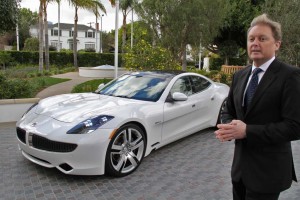This is a complete update of TheDetroitBureau.com’s earlier report.
About 75% of the workforce at troubled battery-car start-up Fisker Automotive has been laid off, including its entire communications staff and much of its marketing and engineering operations, a move forced by the firm’s increasing weak financial situation and the mounting fears that without new investors or partners Fisker could be forced into bankruptcy, numerous sources have confirmed.
The move comes only days after U.S. employees reported back after a week-long, unpaid furlough, and less than a month after founder and former Chairman Henrik Fisker resigned over “several major disagreements” with members of the small carmaker’s senior management team over its ongoing business strategy.
“Unfortunately we have reached a point where a significant reduction in our workforce has become necessary,” the company said, adding that it was still searching for a strategic partner.
According to sources, the firm is effectively being run by the big gun among its investors, the Silicon Valley-based venture capital fund Kleiner Perkins Caufield Byers, which has been pressing Fisker to “conserve cash” and try to line up new investors, partners or buyers.
But efforts to do so have collapsed, according to sources. Several Chinese partners were talking to Fisker as recently as last month, including Dongfeng Motor Corp., based in Wuhan, China, which reportedly had considered purchasing 85% of the U.S. company. Also reportedly in talks was Zheijangg Geely, the Chinese firm that owns Swedish automaker Volvo.
Both Chinese firms have pulled out of the discussions – though one insider cautioned, “The Chinese play hardball and may be taking advantage of the situation to get their best deal.”
At this point it is not clear what position is being taken by law firm Kirkland & Ellis, which has been brought in to advise on a possible bankruptcy filing.
Calling the layoffs “a necessary strategic step in our efforts to maximize the value of Fisker’s core assets,” just 53 managers were asked to remain with the company following the mass firing of 160 employees on Friday morning at its headquarters in Anaheim, California. The company reportedly will provide no severance payments.
Focusing on the plug-in hybrid niche in the nascent electric vehicle market, the company was founded by two industry veterans, Bernard Koehler and the eponymous Henrik Fisker, a Danish designer who was perhaps best known for his work at Aston Martin. Fisker himself tendered his resignation just last month. He had been increasingly isolated from a management team headed by CEO Tony Posawatz who joined the firm last year after leading the development of General Motors’ own plug-in, the Chevrolet Volt.
Even before the official launch of the Fisker Karma in early 2012 the company was running into problems that led the U.S. Department of Energy to freeze most of a $529 million loan intended to help Fisker develop its second, more mass-market model, the Atlantic.
The situation contined to worse as the Karma became subject to several recalls for a variety of problems including a defective fan system that caused one vehicle to burn up. Meanwhile, production of the battery-car at a plant in Finland has been on hold since last autumn.
Despite having raised an estimated $1.2 billion from private investors – and having tapped $193 million before the DoE loan was frozen, Fisker reportedly has just $30 million in available cash at this point. It also is expected to get a settlement of $15 million from its bankrupt battery supplier, the former A123, which was recently sold to a Chinese bidder.
Fisker also faces a $10 payment to the DoE on the outstanding portion of its loan that would be due on April 22.
The Energy Department has come under heat for problems with that program which has seen several other loan recipients, including A123, run into trouble as sales of electric vehicles have lagged well behind early, optimistic forecasts.
In a statement, however, DoE spokeswoman Aoife McCarthy contended that, “Despite Fisker’s difficulties, our overall loan portfolio of more than 30 projects continues to perform very well, and more than 90 percent of the $10 billion loan loss reserve that Congress set aside for these programs remains intact.”


“Focusing on the plug-in hybrid niche in the nascent electric vehicle market, the company was founded by two industry veterans, Bernard Koehler and the eponymous Henrik Fisker,…”
So, in hindsight, focusing on only one tech (no matter how promising it may appear at fist glance) proved dangerous for Fisker.
Because other different rival tech may prove better in the meantime.
Technologies like:
http://www.pattakon.com/pattakonOPRE.htm
http://www.pattakon.com/pattakonPatOP.htm
http://www.pattakon.com/pattakonDesmo.htm
Look at how FIAT and Chrysler thrive, nowadays, on this technology:
http://www.pattakon.com/pattakonHydro.htm
FIAT call this tech MultiAir / UniAir
And Chrysler makes use of it in the Chrysler Dart.